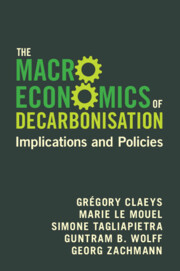Book contents
- The Macroeconomics of Decarbonisation
- Reviews
- The Macroeconomics of Decarbonisation
- Copyright page
- Contents
- Figures
- Tables
- Boxes
- Introduction
- 1 Understanding Deep Decarbonisation over the Long Run
- 2 Understanding Decarbonisation’s Short-Term Disruptions to Economic Activity
- 3 The Distributional Effects of Climate Policy
- 4 Public Finances and Decarbonisation
- 5 Greening Innovation, Industrial and Competition Policies
- 6 Mobilising the Financial System for Decarbonisation
- 7 Decarbonisation and Labour Markets
- 8 Greening Central Banks
- Conclusions
- Index
- References
6 - Mobilising the Financial System for Decarbonisation
Published online by Cambridge University Press: 01 February 2024
- The Macroeconomics of Decarbonisation
- Reviews
- The Macroeconomics of Decarbonisation
- Copyright page
- Contents
- Figures
- Tables
- Boxes
- Introduction
- 1 Understanding Deep Decarbonisation over the Long Run
- 2 Understanding Decarbonisation’s Short-Term Disruptions to Economic Activity
- 3 The Distributional Effects of Climate Policy
- 4 Public Finances and Decarbonisation
- 5 Greening Innovation, Industrial and Competition Policies
- 6 Mobilising the Financial System for Decarbonisation
- 7 Decarbonisation and Labour Markets
- 8 Greening Central Banks
- Conclusions
- Index
- References
Summary
This chapter discusses how decarbonisation will affect capital markets and how capital markets can support decarbonisation. One notable focus is on the risk of ‘stranded assets’, that is assets that lose value because of decarbonisation, and the potential implications for financial stability. The chapter also analyses how capital markets can become a key enabler of decarbonisation, also thanks to new sustainable finance instruments such as green bonds.
- Type
- Chapter
- Information
- The Macroeconomics of DecarbonisationImplications and Policies, pp. 210 - 250Publisher: Cambridge University PressPrint publication year: 2024

